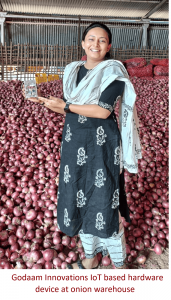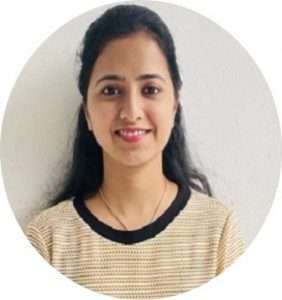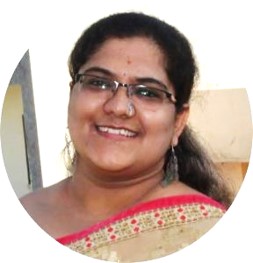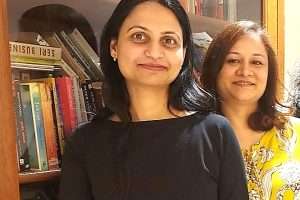“Entrepreneurs should never wait for opportunities to come to them. They should start as early as possible with the available resources, plan and prepare to toil and rise in the domain of entrepreneurship.”
Ms. Kalyani Shinde
Director, Godaam Innovations Pvt. Ltd.
Email: info@godaaminnovations.com
Sejal Agarwal and Bhuvana N conversed with Ms. Kalyani Shinde on her entrepreneurial journey and how the digital tool devised by Godaam is helping onion farmers to reduce produce loss at warehouses.
| Godaam Innovations Pvt. Ltd., based in Nashik, Maharashtra, revolutionizes Agri-tech, empowering farmers and enhancing crop shelf life. They bridge the gap between farmers and consumers, creating a structured, accountable value chain. Their mission is to upgrade the agricultural ecosystem through innovation and technology. For more details, visit https://www.godaaminnovations.com/product/ |
Please tell us briefly about you and how your entrepreneurship journey began.
I was born and raised in Nashik in an agricultural family. Growing up, I gained a deep understanding of the agricultural ecosystem. In 2016-17, while pursuing my engineering degree in computer science, I witnessed a significant issue in the onion market that affected not only my own family but also countless other farmers. I overheard my family discussing the escalating costs, time, and effort involved in onion production, while the fluctuating prices made it an unreliable venture. Often, the prices would be extremely low, discouraging farmers from continuing production. Only once or twice every five years would the market offer appropriate compensation for their efforts. Motivated to find a solution, I turned to the internet for research and discovered that onion warehouse storage was a major challenge faced by farmers. I took up extensive investigation, seeking the perspectives of various stakeholders such as mandi personnel, merchants, farmers, and the government. Despite gathering all this valuable information, I still lacked clear direction on how to address the problem. Eventually, I came across Digital Impact Square (DISQ), an open innovation centre under the Tata Consultancy Services (TCS) Foundation’s CSR initiative in Nashik. Recognizing the potential it held, I applied to DISQ with the intention of finding a solution to the issue of onion pricing. In January 2018, during my final year of engineering, I was selected and began working full-time on the onion storage problem. This marked the birth of Godaam Innovations, and in 2018, Godaam Innovations was officially registered as a private limited company.
How did you begin analysing the problem?
India is the second largest producer of onion. India produces around 3.5 crore metric tons annually of which 70-80 percent is stored in warehouses. As the next harvest can be done only after 8-10 months, its storage is very critical if a continuous supply in both domestic and international markets is to be ensured. However, around 40-50 percent of wastage is reported during storage which leads to fluctuation in prices, which was my main problem statement at Digital Impact Square. I, along with my other teammates whom I met at Digital Impact, started working on this problem. For the first 3-4 months we studied the onion ecosystem, through different stakeholders and at different crop production stages. During the study, we also realised that we need some experts who can guide farmers throughout the crop cycle. Another problem we realised was related to market linkages. Market linkage involves various stakeholders such as farmers, local merchants, and the government. To deal with these stakeholders, there is a need to form a community that can work in partnership and collaboration with all the stakeholders involved. These were the kind of explanations we identified initially based on our analysis during the DISQ incubation period.
How did you develop the digital solution?
After detailed research, we realised that engaging experts or establishing market linkages would require much effort and networking, but making changes at the warehouse storage system level alone can help in reducing the wastage of onion during storage. While interacting with farmers on the warehouse issue, we found that we are able to trace rotten onions through foul smells and height of the onion heaps. However, by the time farmers sense the smell or change in height, they have already suffered a loss of 20-25 percent. Based on these conversations, our team made an IoT- (Internet of Things) based hardware device which monitors real time micro climatic conditions in the storage and also detects the foul smell in the field and during storage.
 IoT based hardware device of Godaam Innovations Pvt. Ltd.
IoT based hardware device of Godaam Innovations Pvt. Ltd.
Can you provide details about the modus operandi?
A single IoT device can provide cover for 10 metric tons in a warehouse, and the number of devices installed are based on the capacity of a warehouse. Based on detection, we alert the farmers who can then either re-grade their produce to increase its life shelf by a month, or sell it in the market immediately so as to reduce wastage. To alert farmers we send text messages to them on their mobile phones; and are planning to develop an application for this at present. We also send bi-weekly alerts for the current status of their crops.
Post-installation, we keep on monitoring the device as a part of their maintenance package. Godaam Innovations also has a dashboard wherein all the data collected through the IoT device is stored and is accessible for tracking the onion quality and quantity on a real time basis. We intend to use this platform to create an end-to-end value chain eventually to show the variety and quantity of the onions stored that can be used to link market traders. This dashboard can be used by cooperatives having warehouse storage (more than a thousand tons) or government representatives with whom they have partnered. We are also in the process of creating an application wherein farmers can get the required details.
How many clients do you have now?
Now, we are present in Madhya Pradesh, Maharashtra and Uttar Pradesh, and have sold more than 250 units of the IoT device. Soon we will be working with 30 farmers by installing our devices in the farmers’ warehouse. We started with individual farmers and have now started focussing on farmer cooperatives and targeting community warehouses. This will help in creating larger impact.
How do you engage in stakeholder collaborations?
Getting into the DISQ programme has helped me and the team to get to know about other programmes. Also, the team has developed the habit of exploring such opportunities that can help us raise funds or find mentorship/guidance support. My personal networks have also helped me to find these opportunities.
 The programme mainly helped me understand how research has to be undertaken, and how to conduct interviews in specific ways so as to get the required information. DISQ also connected me with the ICAR-Directorate of Onion and Garlic Research (DOGR), Pune, for getting domain expertise. TCS has also been supportive in getting inputs and guidance as and when needed. Some experts were identified and onboarded remotely, during the journey, who helped in carrying out the technology-related operations.
The programme mainly helped me understand how research has to be undertaken, and how to conduct interviews in specific ways so as to get the required information. DISQ also connected me with the ICAR-Directorate of Onion and Garlic Research (DOGR), Pune, for getting domain expertise. TCS has also been supportive in getting inputs and guidance as and when needed. Some experts were identified and onboarded remotely, during the journey, who helped in carrying out the technology-related operations.
As I hail from an agricultural background, we did some basic trials in my own circle of farmers However, for large scale testing, we partnered with Tata Trust wherein the latter partly paid for the device and the remaining was paid by farmers so as to share the cost burden. We also partnered with John Deere, a manufacturing company, under the CSR initiative for setting up these IoT devices in our work locations.
We have worked, and continue to work, in collaboration with Tata Steels. We realised that generally the warehouse is a conventional structure and are mostly semi-open. The warehouse size is generally for 50 metric tons which when increased to 500 metric tons, needs to be renovated to make space for proper ventilation and create a controlled environment. Creating cold storage is also not feasible for every location. So, we collaborated with Tata Steel to renovate these warehouses, as 60-70 percent of the construction involves the use of steel. Tata Steel got three warehouses constructed – one each in Madhya Pradesh, Maharashtra and Uttar Pradesh – under the brand name Agronest,[1] India’s first smart warehouse for onion storage. These warehouses provide a controlled environment for onions in terms of temperature and humidity, along with the IoT device installed by us.
Did you get any grants for incubation from the prevailing government programmes for entrepreneurs?
Yes, currently we are a part of two grant programs – BIRAC and Pusa Krishi – and have a received a total grant of around INR 75 Lakhs, along with mentorship and guidance from these centres. We also had a partnership with Tata Center at IIT-Bombay wherein the professors mentored us on data collection and analysis. We were also a part of another incubation programme of ‘UnLtd India’ at Mumbai where we received Rs. 2 lakh as part of the cohort. I have also been a part of Nidhi Fellowship and Pune International Centre which helped me get the required mentorship for my journey. In 2018, we received Rs. 3 lakhs as funding from DOGR, Pune, for starting our pilot.
How big is your team at Godaam Innovations?
In 2018, DISQ formed a team of four member from multiple disciplines sharing similar interests. For the initial six months, the team conducted a study around the topic and prepared a plan. After six months, the plan and prototype were validated by a jury and industry partners. After that validation, the team registered the entity as a private entity. Then there were four members in the team which has now increased to seven, including me. There has been shuffling in the team since 2018, except for the core team of four. Majority of the team members have an engineering background. There is a customer relationship manager with an agriculture background who communicates with customers, potential farmers, and organisations for the product. He is also responsible for collecting feedback from the existing farmers using the device.
Did you face any specific challenges being a woman entrepreneur?
As a woman entrepreneur, I must confess that I did not face any particular challenge owing to my gender. Instead, I think that sometimes people are more open and patient with women, which has benefitted us. There have been occasions when I had to go alone to represent Godaam Innovations in public meetings/forums. However, as I am comfortable and confident in my networking skills, this didn’t affect me in leading things singlehandedly when required.
In team management, we focus on hiring individuals who are aligned with the company’s vision so that they are not affected by stereotypical norms. I believe that ‘if we keep the team together in our journey, they don’t mind taking orders even if it’s coming from a female leader’ (myself).
What are the challenges farmers experienced while using the digital innovations, especially the digital tool of Godaam?
I have come to understand that farmers will not hesitate to use digital innovations if they find value in it. However, the major challenge is the mindset of farmers. Farmers believe that since onion is a perishable item there definitely will be losses in its storage. So, my team and me have to convince farmers on how this IoT device can help them detect foul smell for identifying the rotten stage of onions and reduce their losses. The team makes all-out efforts to help farmers realise that 40-50 percent of their losses can be reduced to 5-10 percent with this technology.
 Discussion with rural onion producers
Discussion with rural onion producers
What is your take on the funding status for entrepreneurs?
I think it is a myth to think that one needs to have funds before starting any enterprise. The basic things necessary are: having a detailed research, good team members in place, and some little funding to test the prototype product/services, and the capital to initiate the work. The programme we have joined, that is Digital Impact Square, provides a monthly stipend for 12-18 months depending upon the idea, for covering personal expenses and creating a company corpus. As of now, we have raised around INR 1 crore through grants and fellowships apart from the revenue created through our IoT device. This has helped us to sustain ourselves in the market. At present, we have not taken any loan.
How do you identify your stakeholders?
There are different kinds of farmers in different regions. We figured out that it is easy to approach and convince progressive farmers who are willing to make the required expenditure for the storage. We didn’t put much effort in convincing each farmer that we came across but pitched our product in front of those who were willing to purchase it. Word of mouth and known farmers also played a role in increasing our reach.
We partnered with like-minded organisations, such as Sahyadri Farms, that helped us get connected to various farmer cooperatives. These cooperatives then paved the way for getting us linked to individual farmers.
In addition to this, we also gave various interviews and wrote articles which helped us to create awareness about our services. This helped us to reach out to more organisations and individuals.
How are your financials?
Depending on factors such as capacity of storage, the startup’s services are packaged into three categories of high, medium, and low. The hardware installations for each are priced between Rs 1 lakh to 1.2 lakh, Rs 70,000 to Rs 90,000, and Rs 30,000 to Rs 40,000, with a monthly charge of Rs 5,000 to Rs 10,000.
The device we market is priced at Rs 11000 and comes with a three-year guarantee. Farmers are required to pay 30 percent annual fee from second year onwards to cover data monitoring, alerts and maintenance of device. This will be approximately Rs. 5000 to Rs. 10000 per month. We get around 30 percent margin on our product cost. We calculated Return on Investment (RoI) for the device and it was found that a farmer is able to cover the cost within one year along with a profit of 10-15 percent on average/year.
 Interaction with farmers
Interaction with farmers
For hardware installation, we mainly have categories based on the storage capacity. For high storage capacity, the installation charges will be around Rs. 1 lakh, for medium storage capacity around Rs. 80,000, and for low storage capacity around Rs.35,000.
For the initial 2-3 years, our expenditure was focused on identifying customers, product development, creating team and market linkage. Post-COVID, from 2021, we started focussing on revenue and have generated around Rs 26 lakh in 2021-22.
Currently, digitalisation is the key to scaling an enterprise. I try to keep the enterprise operations digital to the maximum extent possible apart from the field component that requires device installation and maintenance work.
What are the key motivating factors for you to continue as an entrepreneur?
Firstly, I must mention the trust in our products and services by different people who have been a part of the journey, including partners, farmers, mentors, organisations, etc. Secondly, we are encouraged by seeing the impact our product is creating in the lives of farmers and other stakeholders.
 Honouring Ms.Kalyani’s startup innovation on world women’s day by the Hon’ble Governor of Maharashtra
Honouring Ms.Kalyani’s startup innovation on world women’s day by the Hon’ble Governor of Maharashtra
What is your experience with investors?
From my experience I can only say that an investor looks into different factors such as team structure, vision of the team, product viability and scalability, etc., while investing. There are different kinds of investors with different motives – profit motive, creating impact, and others. So, our enterprise should fall into those categories that interests and impresses investors.
What are your major learnings from your journey as an entrepreneur?
On an entrepreneurial level, we initially started with individual farmers but realised that the business-to-consumer (B2C) model would be a difficult thing to crack during the initial stage due to trust issues and lack of fund for farmers. So, we decided to approach a community of farmers and warehouse for the same which can then help us connect with individual farmers who are willing and (more importantly) can afford the services. We also learnt that focussing just on impact will limit our scale. So, in order to scale, we have to focus on creating business as well.
At a personal level, I realised the importance of learning new things (but at the same time, unlearning too) and also the value of collaboration and networking that determine success of an enterprise. Being an emerging young entrepreneur, I feel that it is a good time now to start as there is a lot of energy, enthusiasm and fewer responsibilities on the personal front as compared to starting an enterprise later in life.
What are your future plans?
In the next 2-3 years, we have plans to scale our products and services to earn a revenue of INR 15-20 crore annually from our work with onion farmers. We also have plans to focus on including other crops that have a longer shelf life, such as potatoes.
I am also a committee member of the National Horticulture Mission for onion value chain, subsidy and warehousing. We are discussing about getting subsidy for our IoT device for farmers, and also pushing our devices into the government warehouses.
What words of wisdom would you like to share with budding entrepreneurs?
From my experience, I can say that budding entrepreneurs should have clarity in theirs mind regarding the business proposition. For instance, does the problem you are trying to solve actually exist, and who is your target audience, as well as financiers and mentors who can support you. Starting at an early age really helps. But they should have clear ideas on the finances needed and mentors who can actually provide support.
Foot Note:[1]https://www.tatasteel.com/media/newsroom/press-releases/india/2020/tata-steel-launches-agronest-by-nest-in-india-s-first-smart-warehouse-for-onion-storage/#:~:text=Press%20Releases-,Tata%20Steel%20launches%20Agronest%20by%20Nest%2DIn%2C%20India’s%20first,Smart%20warehouse%20for%20Onion%20Storage&text=Nest%2DIn%2C%20Tata%20Steel’s%20modular,half%20of%20its%20current%20level.
Acknowledgement: This interview was done as part of the IRRI-CRISP ongoing project “Mapping of Good Practices in Digital innovations in India Supporting Women Agrientrepreneurs”.
 Sejal Agarwal, till recently worked as a Research Fellow at the Centre for Research on Innovation and Science Policy (CRISP), Hyderabad. She recently joined Oorja Development Solutions Limited as Impact Manager She can be reached at sejal.iifm@gmail.com
Sejal Agarwal, till recently worked as a Research Fellow at the Centre for Research on Innovation and Science Policy (CRISP), Hyderabad. She recently joined Oorja Development Solutions Limited as Impact Manager She can be reached at sejal.iifm@gmail.com
 Bhuvana N, is a Consultant at the Centre for Research on Innovation and Science Policy (CRISP), Hyderabad. She has a PhD in Agricultural Extension, from Professor Jayashankar Telangana State Agricultural University, Hyderabad. Her research interests include organizational ecosystems and effectiveness, social networks and technological change. She can be reached at: bhuvanaditya7@gmail.com
Bhuvana N, is a Consultant at the Centre for Research on Innovation and Science Policy (CRISP), Hyderabad. She has a PhD in Agricultural Extension, from Professor Jayashankar Telangana State Agricultural University, Hyderabad. Her research interests include organizational ecosystems and effectiveness, social networks and technological change. She can be reached at: bhuvanaditya7@gmail.com





Add Comment